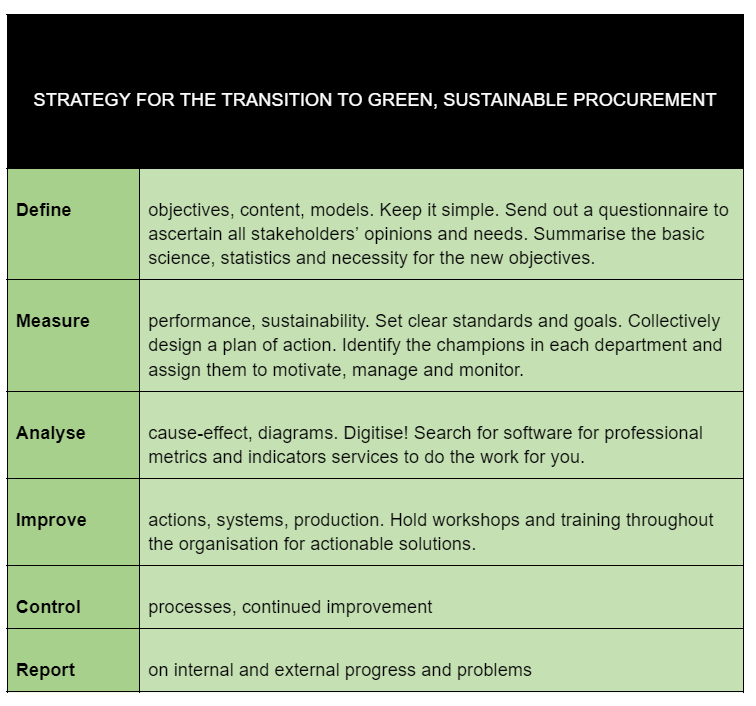Green and sustainable purchasing – what, why and how?
Everything we use every day has an impact on the environment. So why, asks “The Little Green Queen”, Lorraine Jenks in this punchy article, don’t we use the incredible power we have to demand better, safer products with every purchase we make?
Whether as individuals, Chief Procurement Officers or junior buyers in the public or private sectors, we have the capability to implement green or sustainable procurement standards; we have the power to encourage … no, to demand … better practices.
THE WHAT
Green and sustainable procurement means making sure that products we buy have the smallest negative impact on the environment and society.
THE WHY
Procurement at any level, and supply chain management for professionals, is where we can have the greatest influence to reduce the effects of climate change and the devastation of fragile natural ecosystems. An organisation should look beyond its own considerations and look at its effect on the environment, economy and society at large. These concerns are trending in the media worldwide and in public consciousness – it is the consumers who are driving change and demanding higher standards.
THE HOW
This is much easier than we thought. Throughout the value and supply chain, materials and practices should be studied through fresh, environmentally conscious eyes. The primary concerns are impacts on climate change, greenhouse gas emissions, damage to biodiversity and ecosystems (deforestation, overfishing, soil damage, animal extinctions), hazardous materials, air or water pollution, child labour, animal abuse and inadequate care for community welfare and development.
PRODUCT ASSESSMENT
We need to study the lifecycle of a product using a life cycle assessment tool. Where and how were raw materials sourced (deforestation, child labour, indigenous people)? How far and how are items transported? What negative impacts are there during manufacture (pollution, slave labour)? Packaging (recycled or recyclable, plastic)? During use (allergies, toxins)? Disposal (reuse, recycle, return, repair … recycling plastic is a scam! We must switch off production, not only mop up the mess)? And measure energy, water and waste management throughout.
LABELS
Look for labels like Organic, FSC for wood, MSC for fish, Fair Trade for labour and many more. To start, at least find the “greenest” you can; greener than the industry standard, local, organic, well into its sustainability journey. We can’t wait forever for labels. We’ll all be dead. Labels are wonderful, but they intimidate, confuse and overwhelm. Just do the absolute best that you can, and the rest will follow.
BARRIERS
Barriers are discouraging but we’ve learned that they are surprisingly easy to overcome. You will certainly come across:
- Negative attitude of stakeholders
- Financial constraints
- Inferior technology
- Habitual operations
- Inappropriate structures
- Preconceptions
BENEFITS
Studies have shown that green and sustainable practices have positive impacts on areas not immediately obvious. Improvements and positive outcomes are evident throughout the lifecycle of products from production through to consumption and final disposal. Green and sustainable procurement:
- increases competitive advantage, legislative compliance, revenue, trade with like-minded companies and the company’s positive image.
- improves brand reputation, customer satisfaction, continuity of supply, security of supply, innovation and job creation.
- reduces costs, water waste, overheads, greenhouse gas emissions, fuel consumption, environmental impacts and reputational damage.
STRATEGY
This table that provides guidelines on how to transition to the new standards:

Join me on LinkedIn and come to my workshops for facts, fixes, techniques and templates – tools that do the work for you – the knowledge that gives you the courage to be a change agent and the skills to make your company a leader in ESG.
We are not trying to save the planet. The planet will survive. We are saving the future for our grandchildren; a safer, more resilient future. Future generations will ask you if you knew and what you did.
Be warned! Once you become interested in the sustainability of products, your curiosity will become your calling. It will be fun or infuriating, even addictive. But your sustainability journey will be the most interesting and rewarding work you have ever done. Let it be your legacy.
By Lorraine Jenks, Global TEDx Speaker and Climate Reality Leader, Johannesburg. Gutsy, witty and passionate, Lorraine started her journey as an activist against the Vietnam War in California in 1969 and working with the Environmental Protection Agency – and has never looked back. Back in South Africa she launched two successful online not-for-gain online directories of eco-friendly products, used by 33,000 every month. She has 22 awards and honours to her name and is qualified to speak knowledgeably and practically on corporate environmental awareness, going green for all sectors, climate change in Africa and sustainable and ethical food trends.


